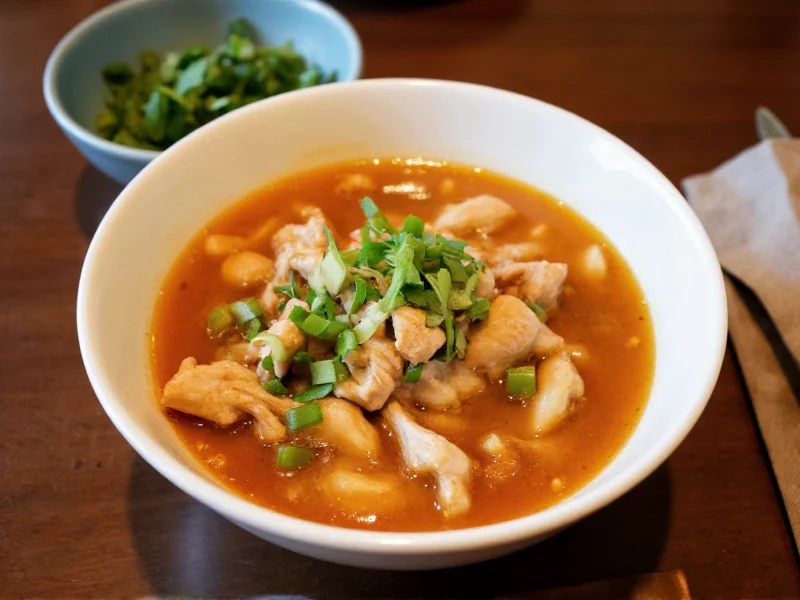When exploring Asian chicken soup, you're delving into one of the world's most diverse culinary traditions. From the healing ginseng chicken soup of Korea to the aromatic pho ga of Vietnam, each variation tells a story of cultural heritage and culinary wisdom passed through generations. These soups aren't just comfort food—they represent centuries of culinary evolution where every ingredient serves a purpose, whether for flavor balance, medicinal properties, or cultural significance.
Understanding Asian Chicken Soup Traditions
Asian chicken soup encompasses numerous regional specialties, each with distinctive ingredients and preparation methods. While Western chicken soup often relies on heavy cream or roux-based thickeners, authentic Asian versions prioritize clarity of broth and layering of flavors through careful simmering techniques. The foundation typically begins with chicken bones simmered for hours to extract maximum flavor while maintaining a clean, light profile.
Key Components of Authentic Asian Chicken Broth
The magic of exceptional Asian chicken soup lies in its foundational elements:
- Aromatic base - Ginger, garlic, and scallions form the flavor foundation in most variations
- Umami enhancers - Dried shiitake mushrooms, fish sauce, or fermented bean paste add depth
- Herbal elements - Regional herbs like cilantro, Thai basil, or Chinese celery provide freshness
- Acid components - Lime juice, rice vinegar, or tamarind balance richness
- Texture elements - Noodles, rice, or vegetables add substance without heaviness
Regional Variations Worth Exploring
Understanding the differences between regional Asian chicken soups helps you select the perfect variation for your taste preferences and dietary needs:
| Regional Variation | Signature Ingredients | Distinctive Characteristics |
|---|---|---|
| Chinese Herbal Chicken Soup | Ginseng, goji berries, dried longan | Medicinal properties, clear broth, often served during recovery |
| Japanese Tori Paitan | Chicken bones, ginger, garlic | Creamy white broth achieved through vigorous boiling |
| Thai Coconut Chicken Soup (Tom Kha Gai) | Coconut milk, galangal, lemongrass, kaffir lime leaves | Sweet, sour, spicy balance with creamy texture |
| Vietnamese Pho Ga | Star anise, cinnamon, charred onion, rice noodles | Clear broth with delicate spice notes, served with fresh herbs |
| Korean Samgyetang | Whole young chicken stuffed with glutinous rice, ginseng | Nutritious summer dish served in the chicken's cavity |
Perfecting Your Homemade Asian Chicken Soup
Creating authentic-tasting Asian chicken soup requires attention to technique as much as ingredients. For the clearest broth, start with cold water and gradually bring to a simmer—never a rolling boil. Skim impurities that rise to the surface during the first 20 minutes. For richer flavor without cloudiness, roast chicken bones at 400°F for 30 minutes before adding to the pot.
When preparing authentic Asian chicken soup recipe variations, timing matters significantly. Delicate ingredients like fresh herbs and leafy greens should be added in the final minutes of cooking. For optimal flavor extraction from spices like star anise or cinnamon sticks, add them midway through simmering. Acidic components like lime juice work best when added just before serving to preserve their bright flavor.
Health Benefits Beyond Comfort
Traditional Asian chicken soups offer more than just comfort—they're often formulated with specific health benefits in mind. The Asian chicken soup health benefits include:
- Natural electrolytes from simmered bones that aid hydration
- Anti-inflammatory properties from ginger and garlic
- Easily digestible protein for recovery periods
- Customizable sodium levels compared to commercial broths
- Rich in collagen from properly prepared bone broth
Unlike many Western versions, most traditional Asian chicken soups are naturally gluten-free Asian chicken soup options when prepared without soy sauce (substitute with coconut aminos). The emphasis on fresh ingredients and balanced flavors creates a nourishing meal that supports overall wellness.
Adapting Traditional Recipes for Modern Kitchens
While traditional preparation methods require hours of simmering, you can create satisfying quick Asian chicken soup recipe versions without sacrificing authenticity. Pressure cookers reduce broth preparation time from 4-6 hours to under 45 minutes while still extracting maximum flavor. For weeknight meals, prepare broth in large batches and freeze in portions for instant access to authentic base.
When adapting recipes, maintain the essential flavor profile by preserving the core aromatic trio (ginger, garlic, scallion) even when shortening cooking times. For how to make clear Asian chicken broth quickly, use chicken breast instead of bones for a lighter, faster-cooking option that still delivers clean flavor.
Serving Traditions and Accompaniments
In Asia, chicken soup rarely stands alone. Understanding traditional serving methods enhances authenticity:
- In Vietnam, pho ga is served with a plate of fresh herbs, bean sprouts, and lime wedges
- Japanese chicken soups often accompany rice and pickled vegetables
- Thai versions typically include chili paste and fish sauce for customization
- Korean samgyetang is traditionally eaten on hot summer days for stamina
For the most authentic experience with your authentic Asian chicken soup recipe, serve immediately after preparation. The volatile aromatic compounds in ingredients like cilantro and lime leaves diminish quickly, so add these fresh elements at the table when possible.
Storage and Reheating Best Practices
Proper storage maintains quality of your homemade Asian chicken soup. Cool broth rapidly by placing the pot in an ice bath before refrigerating. Store components separately when possible—keep noodles, herbs, and delicate vegetables separate from the broth. Consume within 3-4 days for optimal flavor, or freeze broth in airtight containers for up to 6 months.
When reheating traditional Asian chicken soup ingredients, avoid boiling which can make chicken tough and cloud the broth. Gently warm over medium-low heat until just simmering. Add fresh herbs and acid components after reheating to preserve their bright flavors.











 浙公网安备
33010002000092号
浙公网安备
33010002000092号 浙B2-20120091-4
浙B2-20120091-4